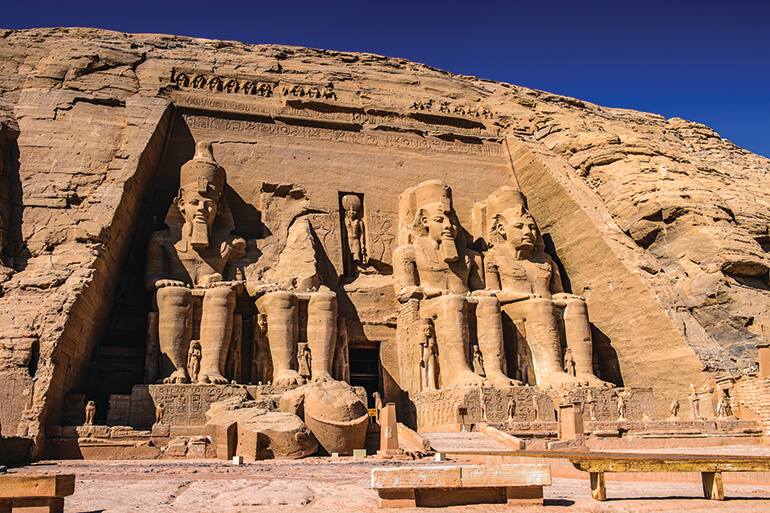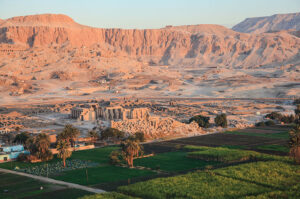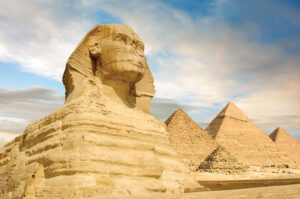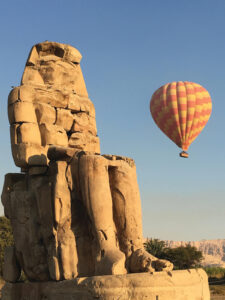
Destination Egypt Part 1: Our Cruise Report from the Valley of the Nile
Two of our team members, Robyn, Product Manager, and Branka, Senior Program Manager, were lucky enough to be able to explore Egypt on a recent trip. Robyn has been in the travel industry for 25 years, and eight of those years have been with Go Next. She’s been to four of the seven continents and 30 countries. Branka has been in the travel industry for 39 years—25 of which have been with Go Next! She’s been to all of the continents save Antarctica, where she plans to go in January. A recent count of countries visited landed her at 112. We were excited to sit down with these two well-seasoned globetrotters and talk with them about their Egyptian adventures!
Here is the first installment of our two-part interview, in which Branka and Robyn share their thoughts and impressions about Egypt—the Nile River, the ancient sites, and life in bustling Cairo and the surrounding cities.
________________________________________________
Egypt is such a historic country—there is so much to see! What were your first impressions?
Branka: I am fortunate to have previously explored the sources of both the Blue and White Nile [in Ethiopia and Burundi], so it was great to see the Egyptian portion of the world’s longest river. For me, the main impression was to see that life along the Nile has barely changed in thousands of years. It’s almost Biblical. If you were to take satellite dishes off the homes and remove the tourists, it would be like going back in time.
Robyn: I guess for me, upon landing in Cairo and transferring to the hotel, the first things I noticed were the sights and sounds… At first look, the city is bustling with people and there is a sense of mixing the current with the ancient. You can look one way and see a billboard advertising McDonalds and look another direction and see ancient architecture. I was amazed at the action, the traffic, the horns honking, the palm-lined streets.

Valley of the Kings
What were some of your favorite sites?
R: It is so hard to just pick a few. It was incredible to see the Pyramids of Giza and the Sphinx. Pictures in travel books and seeing them on TV just doesn’t do them justice. When I was walking up the Great Pyramid, I was speechless. I kept telling myself, “This is a wonder of the ancient world!”
B: The Great Pyramids are amazing, and their age alone is dumbfounding!

Sphinx and Great Pyramids of Giza
Did you see King Tut’s Mask?
B: Yes—King Tut’s original tomb in the Valley of the Kings is currently an empty chamber… everything found there has been moved to the museums in Cairo. We did see his mask and other paraphernalia found in the tomb in the Cairo National Museum.
R: In addition to his mask, it was interesting to learn that he was buried in a series of coffins, two of which are displayed at the museum. We saw his gold-covered throne and many other artifacts.

King Tut’s mask
What was the rest of Egypt like? How did you feel as a tourist?
B: It’s obvious that tourism is valued in Egypt. Security is high, but not intimidating. Tourists are certainly welcome and at no time did I feel in danger or intimidated. It’s surprising how many tourists there were everywhere. That said, the sites are spread out, so it rarely felt overcrowded. Egyptians are friendly, welcoming… and very handsome!
R: We felt very welcomed everywhere. Hotel staff, boat staff, and local guides treated as guests of the country. Everyone was truly interested in talking about their country and culture. We had a dedicated Egyptologist on our trip, which made our visit seem extra personal.

What are the benefits of traveling with an Egyptologist?
R: On our upcoming Egyptian Wonders trip in 2020, our groups will have the same Egyptologist from the minute they arrive in Cairo until the very end of the trip. They travel with them, go on the cruise with them, and they’ll be on every tour. The Egyptologist is the expert of the country, culture, customs… of everything. These Egyptologists have done university time, project time, studying time. They’ve done a lot of volunteering. They’re highly trained, highly knowledgeable, and reputable.
B: Traveling without an Egyptologist is like traveling without a suitcase! They’re the equivalent of what we’d call a tour guide anywhere else in the world, except they have to go through in-depth education on very complicated Egyptian history. They do the same route time and time again, so they know all the shortcuts and they know people who can assist them. That is all a huge benefit for the group.
What kind of souvenirs can you get in Egypt that you can’t get anywhere else?
B: There are several items like alabaster carvings, papyrus, and Egyptian cotton that are typical for the area. The important thing to remember is, buy it when you see it! There were also small market stalls near the ship landing sites.

Egyptian bazaar
When you were at the market, did you try to haggle?
B: Bargaining is part of the culture, and it’s recommended to have cash in U.S. dollars or euros in small notes. Some people have a knack for bargaining and others don’t, so it’s a very personal thing. It’s important to be firm and stick to the offer. Start at 40-50% of the asking price and then give in just a little. Turning to go away or even walking out of the store is the best way to have the seller follow you!
Did you opt into the sunrise hot air balloon ride?
B: Yes! I have done balloon rides before and always find it amazing to go up in the air. There’s nothing scary about it, unless you don’t like heights. In one word, it was a MAGNIFICENT experience and probably the best way to see the West Bank and the Valley of the Kings. Worth every dollar! The best photos were from the balloon… to see it all from the air and to realize the sheer extent of the area—it’s impossible from the ground.
R: Even though we were up at four in the morning this balloon ride over Luxor and the Valley of the Kings was an absolute highlight. Watching the setup, inflating the balloons, and soaring up into the sky for a bird’s-eye view was incredible. Looking down from above and seeing the desert, mountains, museums, and valley is an experience you don’t want to miss. With everything to see, you almost forget that the sun is rising as well. It’s the perfect way to start your day.

Optional hot-air balloon ride, Luxor
How long did the balloon ride last?
R: We were up in the air for about an hour. But the entire excursion lasts about three hours, and that includes transfers and a ferry ride to the West Bank. Guests will arrive with time to watch the crews inflating the balloons and setting off. The only job we had was to be passengers and enjoy the ride.
Is there anything else you want our readers to know about your trip?
R: We were on the go from the time we stepped off the plane. This is a once-in-a-lifetime trip, and our program covers a lot of ground. From Alexandria to Cairo to Abu Simbel… and then we have a Nile cruise in the middle. We definitely have a complete program. Bring your camera or multiple cameras! I had my phone camera and my regular camera. I was swapping between both. I was taking pictures of everything. And I never missed a sunset, because they were so beautiful over the Nile River.
________________________________________________
Join us next week to read part two of the interview with Robyn and Branka and find out more about our once-in-a-lifetime Egyptian experience!